人教PEP版小学六年级英语下册期末测试题及答案听力材料
- 格式:doc
- 大小:40.06 KB
- 文档页数:5
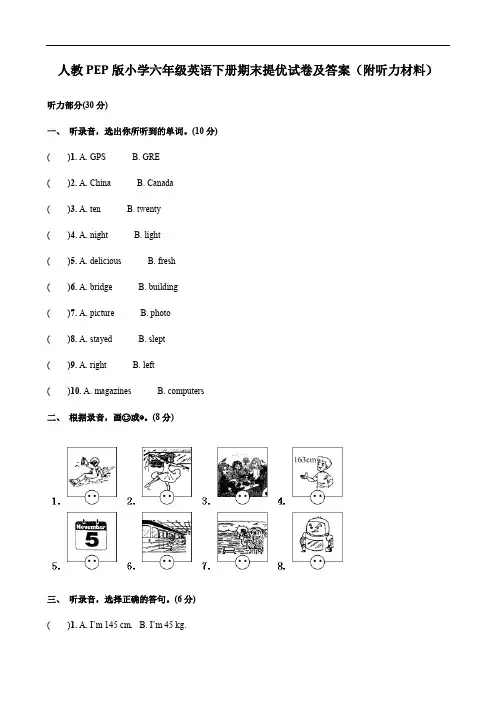
人教PEP版小学六年级英语下册期末提优试卷及答案(附听力材料)听力部分(30分)一、听录音,选出你所听到的单词。
(10分)()1. A. GPS B. GRE()2. A. China B. Canada()3. A. ten B. twenty()4. A. night B. light()5. A. delicious B. fresh()6. A. bridge B. building()7. A. picture B. photo()8. A. stayed B. slept()9. A. right B. left()10. A. magazines B. computers二、根据录音,画☺或☹。
(8分)三、听录音,选择正确的答句。
(6分)()1. A. I’m 145 cm. B. I’m 45 kg.()2. A. Yes, it is. B. Yes, they are.()3. A. Thank you. B. Happy birthday!()4. A. Yes, he does. B. No, she doesn’t.()5. A. She works in a factory. B. She goes to work by bus.()6. A. I like fish noodles best. B. I’d like some fish and noodles.四、听录音,判断句子的正(√)误(×)。
(6分)()1. Lily is younger than Lucy.()2. Lily likes reading books in the library.()3. Lily and Lucy went shopping by bus.()4. They bought some fruit and milk.()5. Lily and Lucy visited their father at the hospital.()6. They were not happy.笔试部分(70分)一、理解单词意思,选出与它们同类的单词。
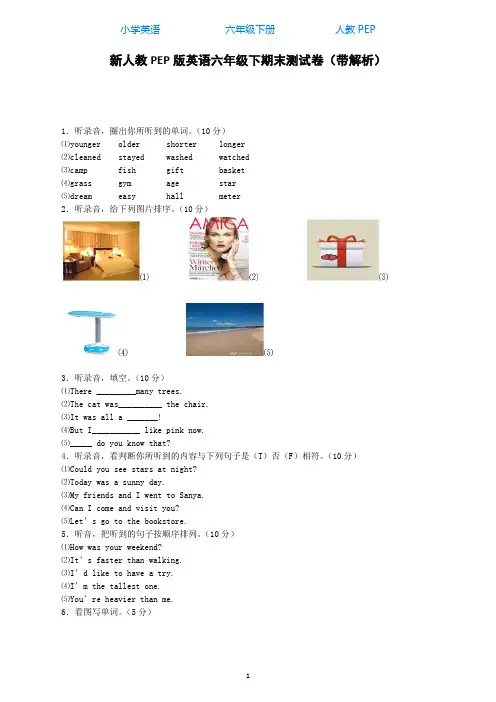
新人教PEP版英语六年级下期末测试卷(带解析)1.听录音,圈出你所听到的单词。
(10分)⑴younger older shorter longer⑵cleaned stayed washed watched⑶camp fish gift basket⑷grass gym age star⑸dream easy hall meter2.听录音,给下列图片排序。
(10分)3.听录音,填空。
(10分)⑴There _________many trees.⑵The cat was__________ the chair.⑶It was all a _______!⑷But I___________ like pink now.⑸_____ do you know that?4.听录音,看判断你所听到的内容与下列句子是(T)否(F)相符。
(10分)⑴Could you see stars at night?⑵Today was a sunny day.⑶My friends and I went to Sanya.⑷Can I come and visit you?⑸Let’s go to the bookstore.5.听音,把听到的句子按顺序排列。
(10分)⑴How was your weekend?⑵It’s faster than walking.⑶I’d like to have a try.⑷I’m the tallest one.⑸You’re heavier than me.6.看图写单词。
(5分)7.找出不同类的单词。
(5分)( )⑴A.woke B. felt C. race( )⑵A.thought B. different C. active( )⑶A.gift B. fix C. go( )⑷A.thinner B. small C. bigger( )⑸A.broken B. easy C. cheetah8.写出单词的相应形式。
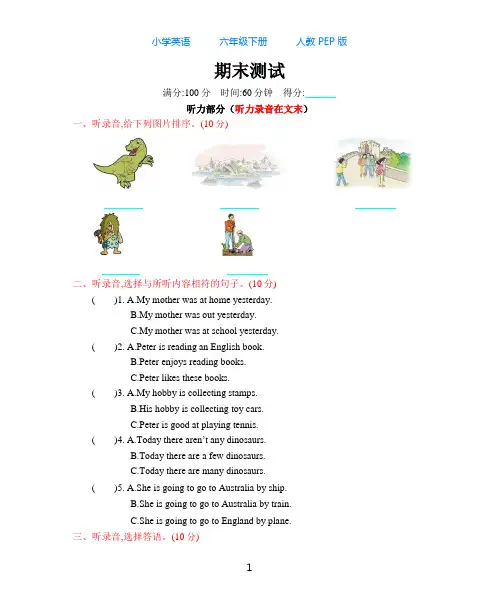
期末测试满分:100分时间:60分钟得分:听力部分(听力录音在文末)一、听录音,给下列图片排序。
(10分)二、听录音,选择与所听内容相符的句子。
(10分)()1. A.My mother was at home yesterday.B.My mother was out yesterday.C.My mother was at school yesterday.()2. A.Peter is reading an English book.B.Peter enjoys reading books.C.Peter likes these books.()3. A.My hobby is collecting stamps.B.His hobby is collecting toy cars.C.Peter is good at playing tennis.()4. A.Today there aren’t any dinosaurs.B.Today there are a few dinosaurs.C.Today there are many dinosaurs.()5. A.She is going to go to Australia by ship.B.She is going to go to Australia by train.C.She is going to go to England by plane.三、听录音,选择答语。
(10分)()1. A.It is wonderful! B.It was fantastic! C.It is exciting!()2. A.On September 10th. B.On May 1st. C.On March 12th.()3. A.It is in Shanghai. B.It is in Tianjin. C.It is in Beijing.()4. A.Tower Bridge. B.Disneyland. C.Niagara Falls.()5. A.I learned a lot from textbooks.B.I can make a cake.C.I learn to interview people.四、听录音,补全句子。
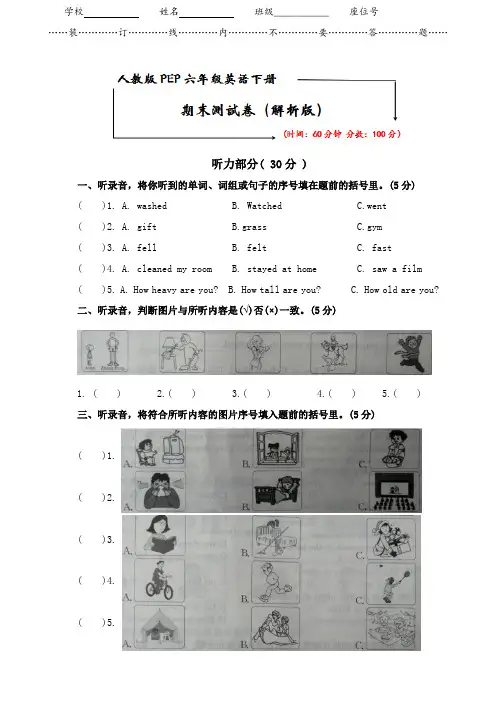
听力部分( 30分 )一、听录音,将你听到的单词、词组或句子的序号填在題前的括号里。
(5分)( )1. A. washed B. Watched C.went( )2. A. gift B.grass C.gym( )3. A. fell B. felt C. fast( )4. A. cleaned my room B. stayed at home C. saw a film( )5. A. How heavy are you? B. How tall are you? C. How old are you?二、听录音,判断图片与所听内容是(√)否(×)一致。
(5分)1.( )2.( )3.( )4.( )5.( )三、听录音,将符合所听内容的图片序号填入题前的括号里。
(5分)( )1.( )2.( )3.( )4.( )5.学校姓名班级___________ 座位号……装…………订…………线…………内…………不…………要…………答…………题……四、听录音,选出所听问题的答案。
(5分)( )1. A. Size 8 B. 72 cm.( )2.A. He is 1.61 metres. B.He is 12 years old.( )3. A. I cleaned my room. B. She washed clothes.( )4. A. Yes, we did. B. No, he didn't.( )5. A. I went to the park. B. It was fine.五、听录音,根据所听短文内容,判断正(T)误(F)。
(10分)( )1. Chen Jie cooked noodles last Sunday.( )2. Chen Jie watched TV last Sunday.( )3. Chen Jie did homework last Sunday.( )4. Chen Jie played football last Sunday.( )5. Chen Jie is going to draw pictures next Sunday.笔试部分(70分)六、选择与下列图片相符的单词或短语。
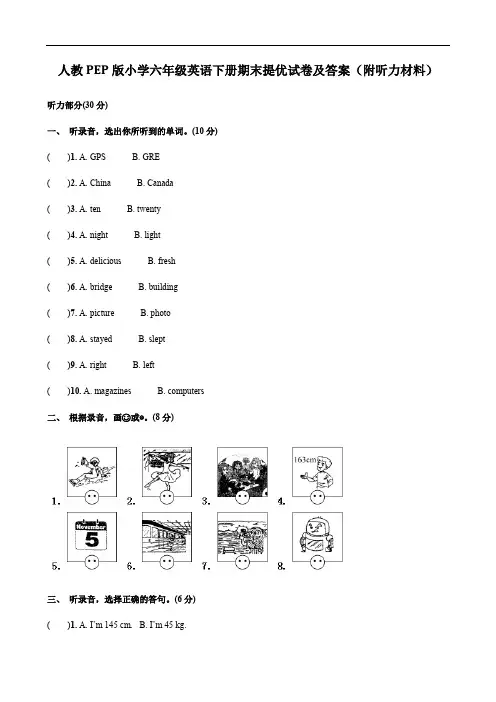
人教PEP版小学六年级英语下册期末提优试卷及答案(附听力材料)听力部分(30分)一、听录音,选出你所听到的单词。
(10分)()1.A. GPS B. GRE()2.A. China B. Canada()3.A. ten B. twenty()4.A. night B. light()5.A. delicious B. fresh()6.A. bridge B. building()7.A. picture B. photo()8.A. stayed B. slept()9.A. right B. left()10.A. magazines B. computers二、根据录音,画☺或☹。
(8分)三、听录音,选择正确的答句。
(6分)()1.A. I’m 145 cm. B. I’m 45 kg.()2.A. Yes, it is. B. Yes, they are.()3.A.Thank you. B. Happy birthday!()4.A. Yes, he does. B. No, she doesn’t.()5.A. She works in a factory. B. She goes to work by bus.()6.A. I like fish noodles best. B. I’d like some fish and noodles.四、听录音,判断句子的正(√)误(×)。
(6分)()1.Lily is younger than Lucy.()2.Lily likes reading books in the library.()3.Lily and Lucy went shopping by bus.()4.They bought some fruit and milk.()5.Lily and Lucy visited their father at the hospital.()6.They were not happy.笔试部分(70分)一、理解单词意思,选出与它们同类的单词。
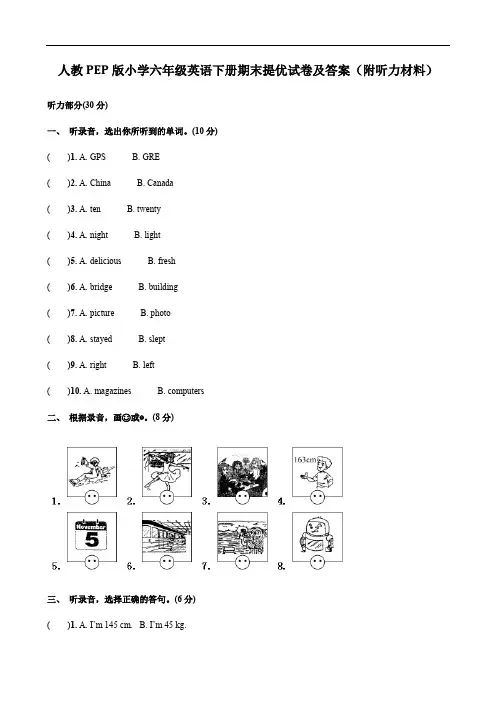
人教PEP版小学六年级英语下册期末提优试卷及答案(附听力材料)听力部分(30分)一、听录音,选出你所听到的单词。
(10分)()1.A. GPS B. GRE()2.A. China B. Canada()3.A. ten B. twenty()4.A. night B. light()5.A. delicious B. fresh()6.A. bridge B. building()7.A. picture B. photo()8.A. stayed B. slept()9.A. right B. left()10.A. magazines B. computers二、根据录音,画☺或☹。
(8分)三、听录音,选择正确的答句。
(6分)()1.A. I’m 145 cm. B. I’m 45 kg.()2.A. Yes, it is. B. Yes, they are.()3.A.Thank you. B. Happy birthday!()4.A. Yes, he does. B. No, she doesn’t.()5.A. She works in a factory. B. She goes to work by bus.()6.A. I like fish noodles best. B. I’d like some fish and noodles.四、听录音,判断句子的正(√)误(×)。
(6分)()1.Lily is younger than Lucy.()2.Lily likes reading books in the library.()3.Lily and Lucy went shopping by bus.()4.They bought some fruit and milk.()5.Lily and Lucy visited their father at the hospital.()6.They were not happy.笔试部分(70分)一、理解单词意思,选出与它们同类的单词。
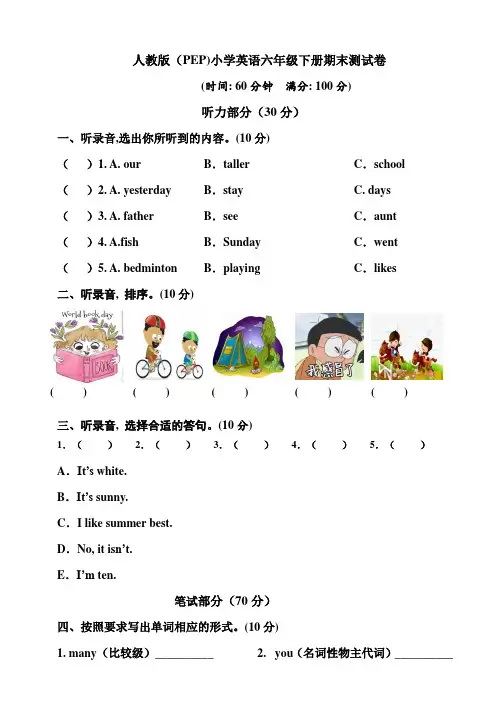
人教版(PEP)小学英语六年级下册期末测试卷(时间: 60分钟满分: 100分)听力部分(30分)一、听录音,选出你所听到的内容。
(10分)()1. A. our B.taller C.school()2. A. yesterday B.stay C. days()3. A. father B.see C.aunt()4. A.fish B.Sunday C.went()5. A. bedminton B.playing C.likes二、听录音, 排序。
(10分)( ) ( ) ( ) ( ) ( )三、听录音, 选择合适的答句。
(10分)1.()2.()3.()4.()5.()A.It’s white.B.It’s sunny.C.I like summer best.D.No, it is n’t.E.I’m ten.笔试部分(70分)四、按照要求写出单词相应的形式。
(10分)1. many(比较级)__________2. you(名词性物主代词)__________3. taller(反义词)__________4. good(副词)______5.there(对应词)________6.will not(缩写)________7. beach(复数)_______ 8. happy(反义词)________9.hurt(过去式)_______ 10. watch(第三人称单数形式)_______五、看图填入所缺单词。
(10分)1 2 3 4 5六、选择最佳答案。
(10分)()1.Now I love football.A. to play B.playing the C. to play the ()2.What you feel worried?A.make B.makes C.making ()3.People go by bus the Tang dynasty.A./,at B.didn’t,on C.didn’t,in ()4.One day I visit the moon.A.am B./C.am going to ()5.Robin is not !1.That’ s the dinosaur!2.Your are bigger than mine.3.No, I an hour ago.4. I in a forest park last Saturday.5.Now there’s a new in our school.A.sell B.sale C.for sale七、根据要求变换下列句型。
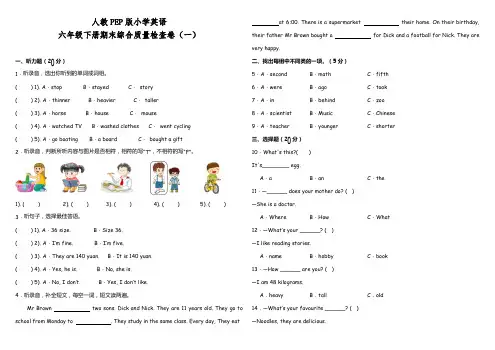
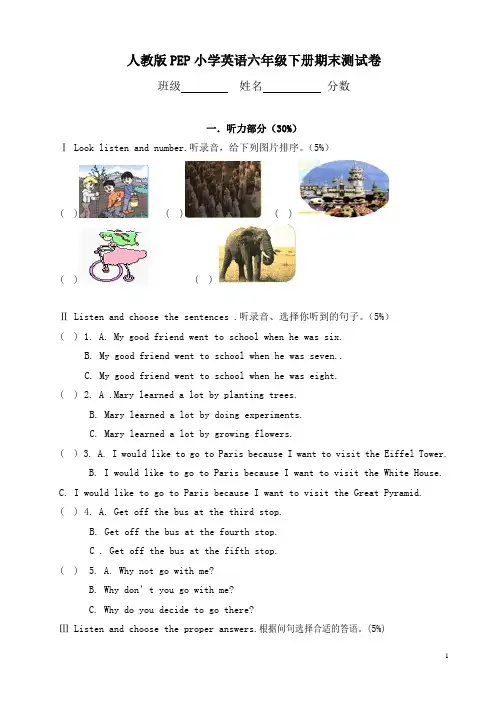
人教版PEP小学英语六年级下册期末测试卷班级姓名分数一.听力部分(30%)Ⅰ Look listen and number.听录音,给下列图片排序。
(5%)( ) ( ) ( )( ) ( )Ⅱ Listen and choose the sentences .听录音、选择你听到的句子。
(5%)( ) 1. A. My good friend went to school when he was six.B. My good friend went to school when he was seven..C. My good friend went to school when he was eight.( ) 2. A .Mary learned a lot by planting trees.B. Mary learned a lot by doing experiments.C. Mary learned a lot by growing flowers.( ) 3. A. I would like to go to Paris because I want to visit the Eiffel Tower.B. I would like to go to Paris because I want to visit the White House.C. I would like to go to Paris because I want to visit the Great Pyramid.( ) 4. A. Get off the bus at the third stop.B. Get off the bus at the fourth stop.C . Get off the bus at the fifth stop.( ) 5. A. Why not go with me?B. Why don’t you go with me?C. Why do you decide to go there?Ⅲ Listen and choose the proper answers.根据问句选择合适的答语。
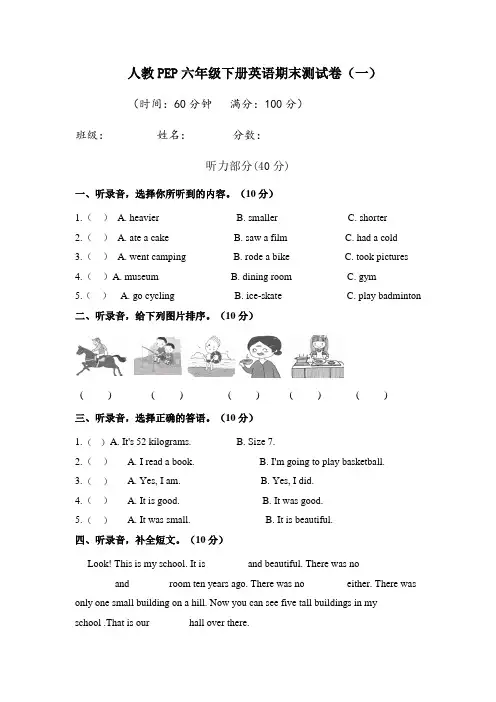
人教PEP六年级下册英语期末测试卷(一)(时间:60分钟满分:100分)班级:姓名:分数:听力部分(40分)一、听录音,选择你所听到的内容。
(10分)1.()A. heavier B. smaller C. shorter2.()A. ate a cake B. saw a film C. had a cold3.()A. went camping B. rode a bike C. took pictures4.()A. museum B. dining room C. gym5.() A. go cycling B. ice-skate C. play badminton二、听录音,给下列图片排序。
(10分)( ) ( ) ( ) ( ) ( )三、听录音,选择正确的答语。
(10分)1.()A. It's 52 kilograms. B. Size 7.2.() A. I read a book. B. I'm going to play basketball.3.() A. Yes, I am. B. Yes, I did.4.() A. It is good. B. It was good.5.() A. It was small. B. It is beautiful.四、听录音,补全短文。
(10分)Look! This is my school. It is________ and beautiful. There was no________and________room ten years ago. There was no ________either. There was only one small building on a hill. Now you can see five tall buildings in myschool .That is our________hall over there.笔试部分(60分)五、根据提示写单词,补全句子。
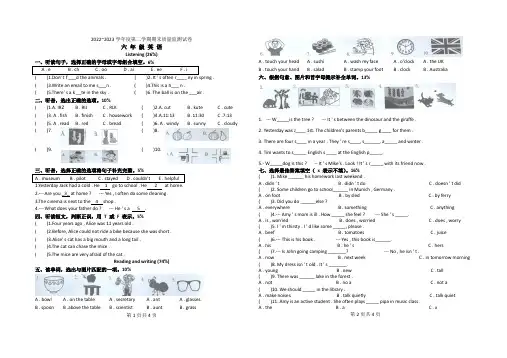
2022~2023学年度第二学期期末质量监测试卷六年级英语Listening (26%)一、听读句子,选择正确的字母或字母组合填空。
6%A . eB . chC . ooD . aiE . eeF . i( )1.Don' t f ___d the animals . ( )2. It ' s often r____ ny in spring .( )3.Write an email to me s___n . ( )4.This is a h___ n .( )5.There' s a k __te in the sky . ( )6. The ball is on the ___air .二、听音,选出正确的选项。
10%( )1.A. IRZ B . RIJ C . RLK( )2.A. cut B . kute C . cute ( )3. A . fish B . finish C . housework( )4.A.11:13 B .11:30 C .7:13 ( )5. A . read B . red C . bread( )6. A . windy B . sunny C . cloudy ( )7.( )8.( )9.( )10.三、听音,选择正确的选项将句子补充完整。
5%A . museumB . pilotC . stayedD . couldn'tE . helpful1.Yesterday Jack had a cold . He 1 go to school . He 2 at home.2.--- Are you _3_ at home ? --- Yes , I often do some cleaning .3.The cinema is next to the 4 shop .4.--- What does your father do ? --- He ' s a 5 .四、听读短文,判断正误,用T 或 F 表示。
人教PEP六年级英语第二学期复习卷1.听录音,在符合录音内容的图片下面的字母上画一圆圈。
(10分)2.听录音,判断下面各张图片是否与内容相符,符合的在该图片下面的括号里打“√”,不符的打“×”。
(10分)3.根据录音内容,在句子的空格中填上单词,将句子补充完整。
每空一词。
(10分)(1)Chen jie is a__________ ________________.(2)If you don’t __________well , it’s easy to have a _____________.(3)I like_________ pictures and _______________ games.(4)We ___________fans and a ____________in the supermarket.(5)There __________a kite show on____________.4.根据对话内容,选出问题的答案,并将该答案的字母符号填在题前的括号里。
(10分)(1)A .It’s Friday.B. It’s Saturday.C. It’s Thursday.(2)A. Yes, he did.B. No, he didn’t.C. She’s 150kg.(3)A. She’s 50kg.B. She’s 15kg.C. She’s 150kg.(4)A. Yes, he did.B. No, he didn’t.C. Yes, he is.(5)A. A student.B. A singer.C. An artist.5.听录音,按听到的内容顺序给下面的图片编号。
(10分)6.选择正确的词填空。
(10分)Mike and John are good _______.Mike is 164cm tall. He is 4cm________than John, and______. John is 14. Mike is only 12. Mike is_______. Usually they _________homework together on Sundays. Last ________, they_________hiking and ________.They________happy. Next weekend, they’re_______to the zoo.7.根据所给的图片回答下面的问题。
Pep版小学六年级毕业考试英语试题等级:Part I Listening 第一部分听力共五大题I. Listen and tick or cross(根据录音,判断正误,对的打“√”,错的打“×”。
)( ) ( ) ( ) ( ) ( )II. Listen and choose the sentence.(听录音, 选出与所听内容意思相符的一句话。
)( ) 1. A. John is 1.65 metres tall. B. John is 1.61 metres tall.C. John is 1.50 metres tall.( ) 2. A. Zhang Peng played football on Sunday.B. Zhang Peng played basketball on Sunday.C. Zhang Peng played football on Saturday.( ) 3. A. Mike is 50 kilograms heavy. B. Mike is 48 kilograms heavy.C. Mike wears size 38 shoes.( ) 4. A. Amy watched TV last weekend. B. Amy cleaned her room last weekend.C. Amy read a magazine last weekend.( ) 5. A. Sarah and her family went to Sanya over the winter holiday.B. Sarah and her sister went shopping last Saturday.C. Sarah and her mother went to Beijing over the winter holiday.III. Listen and number.(听录音, 排序。
人教版英语六年级下册期末考试试卷听力部分(满分43分)一、Listen and choose第一部分共10小题。
你将听到一个单词,请根据读音选择正确的答案,答案填在括号内。
每个单词读两遍。
(每小题0.5分,共5分)() 1. A.cap B.gap() 2. A.led B.red() 3. A.yam B.jam() 4. A.bus B.fox() 5. A.ban B.bam() 6. A.back B.pack()7. A.vast B.fast()8. A.then B.than()9. A.rote B.rope()10. A.mouth B.mouse第二部分共10小题。
你将听到一个句子,选择你所听到的选项。
每小题读两遍。
(每小题0.5分,共5分)() 1. A.party B.pork C.park() 2. A.washing. B.watching. C.catching.() 3. A.coat B.goat C.boat() 4. A.warm B.want C.wall() 5. A.little B.letter C.matter() 6. A.tail B.tell C.tall()7. A.failed B.feel C.tail()8. A.light B.night C.right()9. A.from B.far C.farm()10. A.nice B.rice C.nine二、Listen and circle听句子或对话,把与听力内容相符合的图片圈出来。
每小题读两遍。
读前浏览选项,有助于做出准确而快速的判断!(共10分)1.2.3.4.5.6.7.8.9.10.三、Listen and choose听问题,选择最合适的应答句,答案填在括号内。
每小题读两遍。
记住听前先浏览选项。
(每小题1分,共10分)()1. A.I went to a park. B.I went at9:00. C.I went shopping ()2. A.No,he doesn’t. B.Yes,he is. C.Yes,he can.()3. A.He’s a student. B.He likes apples.C.He’s young and smart.()4. A.No,it isn’t. B.Yes,it’s near. C.Yes,there is.()5. A.It comes from the vapour.B.It comes from the stream.C.It comes from the rain.()6. A.It’s Mike’s. B.He is Mike. C.It’s a comic book.()7. A.Because I like hot days. B.Because it’s too hot.C.Because it’s cold weather.()8. A.She is a great writer. B.She does homework every evening.C.She is active.()9. A.It’s June1st. B.It’s October1st.C.It’s September10th.()10. A.We are listening to music. B.They listened to music.C.They are going to listen to music.四、Listen and fill听对话或独白,填入所缺的单词,使对话意思合理、完整,每空只填一词。
人教版小学六年级英语下册期末试题及答案听力部分(共30分)一、听句子选出句中所包含的单词:5分( )1. A.wash B.washed C.washing D.washed( )2. A. happy B.excited C. tired D.angry( )3. A.tall B.taller C.short D.shorter( )4. A.go B.went C.want D.goes( )5. A.big B.biger C.bigger D.strong二、听问句选答语:5分( ) 1. A.I’m fine. B.I’m nine. C.I’m 50kg.( ) 2. A.The elephant. B. The cat.( ) 3. A.I’m angry B.I have a headache. C. I feel sick.( ) 4. A.Yes, I do. B.Yes, I did. C.No,I did.( ) 5. A.It’s black. B.It’s a clock. C.It’s four o’clock.三、听短文判断正误:10分( ) 1. Jenny’s family was very busy last weekend.( ) 2. Jenny cleaned the floor yesterday.( ) 3. Bob washed his clothes.( ) 4. Father cooked supper.( ) 5. Mother read a newspaper.四.听短文补全对话:10分Today was a fun day. I______my_________, then I _____to Amy’s home in the morning. we ______a story book, then we ______to a park by______. We __________some elephants and_______a_______, we took some________. We were__________.笔试部分一、按要求写词语:10分one (序数词) longer (反义词) thin (比较级) tooth (复数) I (同音词) swim (现在分词) have (第三人称单数) read (过去式) buy(过去式)doesn’t (完全形式)二、选择:15分( ) 1. What_____Amy_____last weekend ?A. did, doB. do, doC. does, do( ) 2. Mike _____his clothes everyday.A. washB.washesC.washed( ) 3. We ______have a football match tomorrow.A. are goingB.are go toC. are going to( ) 4. I failed my English test. I am ______.A. happyB.sadC.excited.( ) 5. How____you feeling?----- I’m feeling better.A. amB. areC. do( ) 6. It’s raining outside. Tom______bored.A. feelB. doesC. feels( ) 7. What did you do yesterday?----- I _____skiing.A. goB.goedC.went( ) 8. How _____are you ?----- I’m 160 cm tall.A. oldB.tallC.heavy( ) 9. My nose______.A. hurtB. hurtsC. is hurting ( ) 10. ______is it ?-----It’s Tuesday.A. What dayB. What colourC. What ( ) 11. Look, they are_____the insects carefully.A. watchB.watchingC.watched ( ) 12. He is an _____, he draws pictures.A. actorB.cleanerC.artist ( ) 13. I played ____piano.A. \B.theC.a( ) 14. I get up ___7:00___the morning.A. at atB. at inC.in in ( ) 15. I like to go ____on Sundays.A. fishingB. to fishC.fish三、连词成句:10分1. likes he listening music to2. did you there how go3. do you when Beijing to go4. have I throat sore a5. two years I’m than you younger四、连线:10分1. What did you do yesterday ? A.I feel sick.2. How do you feel ? B.I climbed a mountain.3. What’s the date ? C.October 1st.4. Where did you go ? D.Yes , I did.5. Did you learn English ? E.I went to Xinjiang.五、情景交际:5分1. 你想约你的朋友周末去滑冰,你可以说:()A.Let's go fishing this weekend. B.Let's go hiking this weekend.C.Let's go ice-skating this weekend.2. 当别人跟你说:May I borrow your dictionary?你回答说:()A.OK,here you are. B.Fine. C.I don't think so.3. 当别人发生不幸的时候你可以问:()A.Not at all. B.I'm sorry to hear that. C.You're welcome.4. 当你想问别人邮局在哪时,你应先说:()A.I' m sorry. B.Hi. C.Excuse me.5. 当有人对你说Happy birthday to you!时,你应说:()A.You too. B.The same. C.Thank you.六、阅读短文,选择正确答案:10分Jack and John are twins. They are good at English. They like to swim and ride bikes in their holidays. They like to fly kites too. They often fly kites near the lake. But they not all the same .Jack likes playing football, but John likes playing ping-pong. Jack likes listening to music, but Jonh likes drawing pictures. They often help each other.1. What are they good at ?()A. EnglishB. MathC. ChineseD. Science2. What do they like to do in their holiday ? ( )A. Play ping-pong and run.B. Swim and ride bikes.C. Swim and play basketball.D. Play ping-pong and ride bikes.3. Where do they fly kites ? ( )A. Near the lake.B. In the park.C. On the beach.D. Near the river.4.Who likes playing football ? ( )A. JackB. JohnC.Jack and John5. Do they often help each other ? ()A. Yes, he does.B. No, he doesn’t.C. Yes, they do.D. No, they doesn’t.七、作文:10分1、介绍自己上周末的活动:What did you do last weekend ?2、写一写你自己(内容可以是你; 你的家庭;你的朋友??????)Write about yourself (you, your family, your friend???)要求:1、任选一项。
六年级英语期末检测题听力部分(30分)一、听句子三遍,选出你所听到的信息,并把其字母编号写在括号内。
(7分)( ) 1. A. Lucy and Kate want to go swimming.B. Lucy and Kate want to go shopping.C. Lucy and Kate want to go sightseeing.( ) 2. A. I don’t like Shenzhen because it’s noisy and crowed.B. I don’t like Shenzhen because it’s busy and boring.C. I like Shenzhen because it’s clean and interesting.( ) 3. A. My birthday party will begin at 8:30 tomorrow evening.B.My birthday party will begin at 8:15 tomorrow evening.C.My birthday party will begin at 7:45 tomorrow evening.( ) 4. A. Mrs Green had a headache last night.B. Mrs Green had a stomachache last night.C. Mrs Green had a tooth-ache last night.( ) 5. A. Mike is going to the cinema. B. Mike is going to the hospital.C. Mike is going to the market.( ) 6. A. I played tennis yesterday. B. I played basketball yesterday.D.I played table tennis yesterday.( ) 7. A. I stay at school for 6 hours. B. I stay at school for 7 hours.C. I stay at school for 8 hours.二、听句子三遍,用英文大写字母给图编号。
小升初英语综合练习题笔试部分(70%)一、用所给词的适当形式填空。
(10%)1.My hobby is (collect) stamps.2.Summer is the (hot) season of the year.3.I (go) to the cinema yesterday.4.We should keep water (clean).5.Look! the children (play) football now.二、选择填空。
(20%)( )1. Different people have different .A. hobby B. hobbies C. a hobby ( )2. We have four classes 8:00 11:30 in the morningA. fro m…toB.at…toC. fro m…and( )3.Some boys enjoy music.A .listen to B. listens to C. listening to ( )4.August is the month of the year.A. eightB. eighthC. twelfth( )5.Spring is the season.A. white B. green C. yellow( )6.I have a map my neighbourhood. A. of B. at C. in( )7.What are you next Sunday?A. goB. to goC. going to do( )8.We can learn about the history of China.A. a lotB. a lot ofC. lots of( )9.Big Ben and Tower Bridge are in .A. America B .London C. Japan( )10. There are visitors come to visit Beijing every year.A. million ofB. thousands ofC. hundred of( )11.He up late this morning.A. getB. getsC. got( )12.My sister likes books in the evening. But she books yesterday evening.A. reading; readB. reading ;didn’t readC. reads ;read( )13.Go straight and turn left the second crossing.A. inB. atC. for( )14.Our teacher taught us more from real life.A. learnB. how to learnC. how learning( )15.We are all very pleased our studies in the school.A. inB. atC. with( )16.I to school when I six.A. come; wasB. came ;wasC. come; is( )17.We shouldn’t cut down trees and waste water.A. too many ; too manyB. too many; too muchC. too much; too much( )18.We should turn the lights when we leave the roomA. onB. offC. in( )19.Our teacher always tells us waste water.A. to notB. not toC. not( )20.The White House is in .A. FranceB. ChinaC. WashingtonD.C.三、按要求改写句子。
(10%)1. I was at the cinema yesterday. (改为否定句)I at the cinema yesterday.2. I went to school by bus last week. (改为一般疑问句)you to school by bus last week?3 .My holiday was exciting. (就划线部分提问)was holiday?4.They will go to Hangzhou by plane. (改为一般疑问句)they to Hangzhou by plane?5.We should save water.(同义句)We shouldn’t water.四.补全对话。
(5%)A: last Sunday?B: Yes, I did. My classmates and I went to plant trees.A: How did you plant trees?B: First, we in the ground. Then, weand put them into the holes.After that, we . We watered the young trees.A: ?B: Yes, they are. They can stop the wind and they can make the air fresh and clean.A: We should plant more trees.(1)Are the trees very important to people?(2)we brought young trees.(3)Did you go to plant trees(4)we used spades to dig holes(5)got water from the river nearby.五、阅读理解。
(15%)(A)阅读短文内容,判断句子正误。
Do you know something about our planet? There are plains, mountains, rivers, lakes, and oceans on our planet. There are all kinds of trees, flowers and grass on our planet. There are allkinds of wild animals living together with us. Don’t you want to keep our planet beautiful ? But sometimes we do bad things to it. We waste too much water. We cut down too many trees. We hunt too many wild animals for our food or clothes … We shouldn’t do these things. We should save our planet because we have only one planet.1.There are all kinds of wild animals and plants on our planet.( )2.Sometimes we do bad things to our planet. ( )3.We don’t hunt too many wild animals for our food or clothes ( )4.We shouldn’t do bad things. ( )5.We should save our planet. ( )(B) 阅读短文,选择正确答案。
I have a good friend. Her name is Lisa. She isn’t a Chinese, but an American. She likes studying in China. She likes Chinese food very much. She spent the Spring Festival in Beijing last year. She was very happy. She watched TV on the eve of the Spring Festival. She ate jiaozi that night. Her father is a worker and her mother is a teacher. They love China very much. They think Chinese people are very friendly.( ) 1. Lisa is an .A. American B. Chinese C. Japanese( ) 2. She spent the Spring Festival in last year.A. ShanghaiB. TianjinC. Beijing( ) 3. She that night.A. ate jiaozi B watched TV C. both A and B( ) 4. What’s her father? A. A teacher B. A worker C. A driver( ) 5.They think Chinese people are .A funny B. friendly C. friend(C) 阅读短文内容,判断句子正误。
It was Sunday. Tom did not go to school. After breakfast, he helped his grandfather in the garden. His grandfather taught him how to grow flowers. But Tom didn’t like growing flowers.He went to the river and helped his grandfather get water. Near the river, he could see lots of yellow leaves on the ground around him on the water. He picked a leaf and looked at it very carefully. It was yellow and brown. What a beautiful leaf! He had a good time.( )1. Tom didn’t go to school on Sunday.( )2. Tom helped his father grow flowers.( )3. Tom like growing flowers.( )4. Tom went to the river and helped his grandfather get water.( )5.Tom didn’t look at the leaf carefully.六、写作(10%)根据所给的时间和动词短语,用过去时态写出Kate 上周六的一日生活(字数不少于60单词)7:00 get up 8:00 have breakfast 10:00 play football 11:30 have lunch2:00 do homework 4:00 go to the cinema 6:00 eat out with friends 7:00 watch TV617六年级英语综合练习题听力材料及参考答案:一、看图、听录音,给下列图形标号。